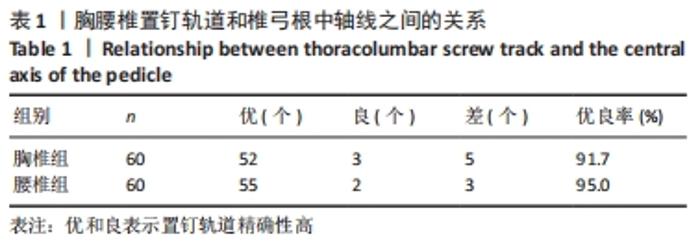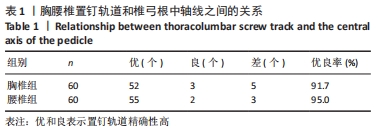[1] HUANG TJ, HSU RW, LI YY, et al. Less systemic cytokine response in patients following microendoscopic versus open lumbar discectomy. J Orthop Res. 2005;23(2):406-411.
[2] FOURNEY DR, DETTORI JR, NORVELL DC, et al. Does minimal access tubular assisted spine surgery increase or decrease complications in spinal decompression or fusion? Spine (Phila Pa 1976). 2010;35 (9 Suppl):S57-65.
[3] 孔祥清,孟纯阳,张卫红,等.微创经皮穿刺椎弓根内固定术治疗胸腰椎骨折的临床疗效观察[J].中国矫形外科杂志,2015,23(8): 692-695.
[4] 黄其杉,彭茂秀,林焱,等.经皮椎弓根螺钉固定治疗胸腰椎骨折[J].中华骨科杂志,2005,25(12):758-760.
[5] 李勤,田伟,刘波,等.导航辅助微创经皮穿刺椎弓根内固定术治疗胸腰椎骨折的疗效观察[J].中华医学杂志,2007,87(19):1339-1341.
[6] 黄志强.“微创”应是外科学发展的理念[J].中国微创外科杂志,2001, 1(1):1-2.
[7] 池永龙.我国微创脊柱外科的今天与明天[J].中国脊柱脊髓杂志, 2004,14(2):70-72.
[8] 李华,张蒲,俞超,等.计算机导航辅助椎弓根螺钉固定[J].中华创伤骨科杂志,2005,7(7):634-636.
[9] 袁翠华,王旭,刘寿坤,等.椎体成形与后凸成形:经皮椎弓根定位的穿刺位置及角度[J].中国组织工程研究,2014,18(35):5730-5733.
[10] 王方永,李建军.胸腰椎椎弓根解剖参数三维分析[J].中国康复理论与实践,2012,18(2):134-136.
[11] 熊传芝,郝敬明,唐天驷.椎弓根钉道参数的变异性及其相关因素的研究[J].中华骨科杂志,2002,22(1):31-35.
[12] RAO G, BRODKE DS, RONDINA M, et al. Comparison of computerized tomography and direct visualization in thoracic pedicle screw placement. J Neurosurg. 2002;97(2 Suppl):223-226.
[13] 田伟,刘亚军,刘波,等.计算机导航系统和C臂机透视引导颈椎椎弓根螺钉内固定技术的临床对比研究[J].中华外科杂志,2006, 44(20):1399-1402.
[14] NEO M, ASATO R, FUJIBAYASHI S, et al. Navigated anterior approach to the upper cervical spine after occipitocervical fusion. Spine (Phila Pa 1976). 2009;34(22):E800-805.
[15] HÄRTL R, LAM KS, WANG J, et al. Worldwide survey on the use of navigation in spine surgery. World Neurosurg. 2013;79(1):162-172.
[16] 禤天航,曹正霖,王刚.骨科导航技术在上颈椎手术的应用进展[J].海南医学,2015,26(8):1180-1182.
[17] FOLEY KT, GUPTA SK. Percutaneous pedicle screw fixation of the lumbar spine: preliminary clinical results. J Neurosurg. 2002;97(1 Suppl):7-12.
[18] SCHEUFLER KM, DOHMEN H, VOUGIOUKAS VI. Percutaneous transforaminal lumbar interbody fusion for the treatment of degenerative lumbar instability. Neurosurgery. 2007;60(4 Suppl 2):203-212.
[19] KHOO LT, PALMER S, LAICH DT, et al. Minimally invasive percutaneous posterior lumbar interbody fusion. Neurosurgery. 2002;51(5 Suppl): S166-181.
[20] 王春,林永绥,刘清平,等.经皮长尾可折U形空心椎弓根钉系统固定治疗胸腰椎骨折的疗效评估[J].中国脊柱脊髓杂志,2012, 22(7):627-633.
|





